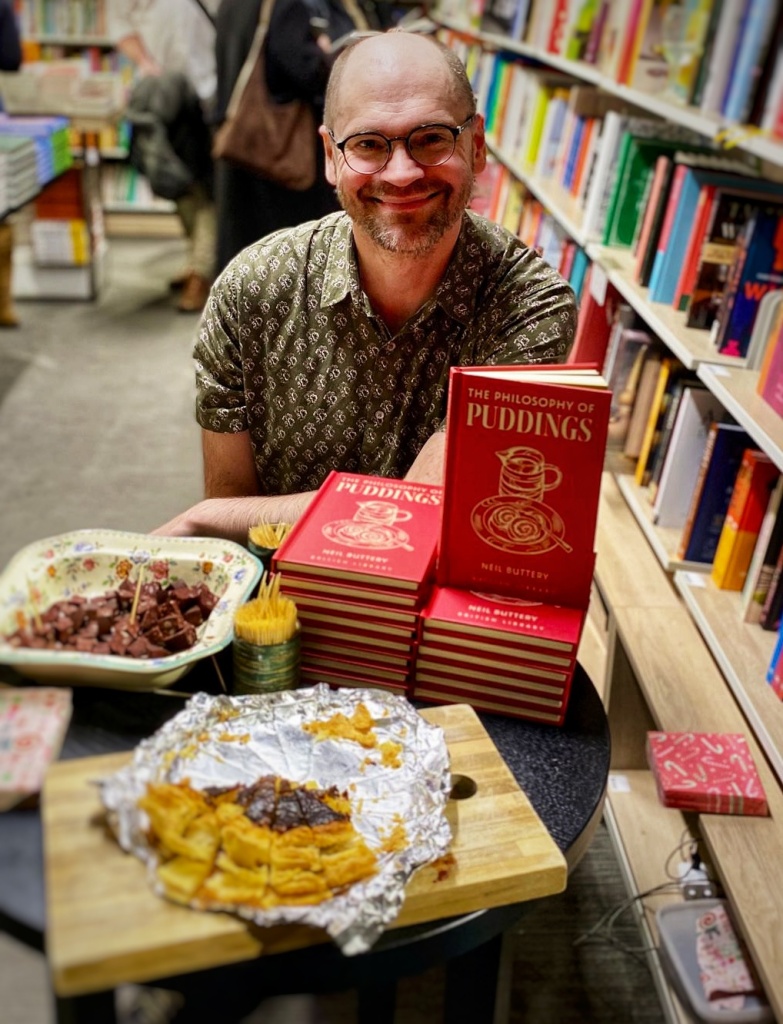I was at the Foyles Winter Evening on the 28th of November promoting The Philosophy of Puddings. It was at their flagship Charing Cross Road store, adjacent to Soho, and it was all very exciting. To draw folk in, I brought two puddings from opposite ends of the pudding spectrum: a nice, but very sweet, Bakewell pudding and a very savoury black pudding. I’m sure you can guess which was the most popular (by the way, tune into this podcast episode to hear about my gaff involving Rick Astley and the black pudding).
I promised I would post the recipe for a Bakewell pudding because it went down so well at the event. A Bakewell pudding is different from a Bakewell tart: the pudding is made up of a puff pastry case, a layer of raspberry jam, and then a sweet mixture of melted butter, eggs, sugar, and ground almonds. It’s very sweet and seems to be derived from a tribe of puddings called transparent puddings.[1]
The recipe for Bakewell pudding is a closely-guarded secret held by the several bakeries in Bakewell who reckon they have the original recipe. I won’t go into the history of the pudding here, it can all be found in the Philosophy of Puddings and Knead to Know.[2] However, Sheila Hutchins provides a recipe in her excellent 1967 book English Recipes and Others which she obtained from ‘Mr Oulsnam, the cook at the Rutland Arms in Bakewell where the pudding was said to be invented’.[3] There are recipes too in Jane Grigson’s English Food (1992) and Regula Ysewijn’s Pride and Pudding (2015). The first recipe appears in Eliza Acton’s Modern Cookery for Private Families (1845), and it doesn’t have a crust, and is made with egg yolks, not whole eggs.[4]
All of the recipes vary slightly, but I have gone with something that resembles the modern version, though my filling has a higher proportion of ground almonds than the Rutland Arms recipe (but not too much because it begins to veer on Bakewell tart territory. I feel I have the balance just right, but you can be the judge of that.
By the way, the finished pudding isn’t a particularly beautiful-looking thing, it won’t come out of the oven looking like French patisserie, it’s wonky and slightly scruffy but very delicious; as a pudding should be.
Apologies for the lack of a photo of the interior! I was stressed on the night and forgot to take one, but here I am with the pudding in Foyles.
If you like the blogs and podcast I produce and would to start a £3 monthly subscription, or would like to treat me to virtual coffee or pint: follow this link for more information. Thank you.
Recipe
My recipe makes 1 x 23 cm/9 inch (approx.) pudding in a round tin with sloping sides. The great thing about puddings is that they are very forgiving, so if your tin has straight sides or fluted edges, or not exactly the right dimensions, don’t worry, it will be fine.
The pastry is not blind-baked first. To avoid the dreaded soggy bottom put a baking tray in the oven so it can get nice and hot. When the pudding is ready to bake, sit it on the very hot tray which will help crisp it up before it starts to turn soggy.
1 batch of Quick and Easy Puff Pastry
120 g butter
120 g caster sugar
80 g ground almonds
2 eggs
A few drops of almond essence
2 to 3 dessertspoons of raspberry jam
Preheat your oven to 220°C and place a baking tray on the centre shelf.
Begin by rolling out the pastry to the thickness of a pound coin (3 mm approximately). Allow to rest for a couple of minutes before lining the tin with the pastry. Make sure the pastry is tucked into the edges properly and that there are no air bubbles. Trim with a knife or rolling pin (whichever is most efficient – depends upon your tin!) and prick the pastry all over with a fork so that it doesn’t puff up too much in the oven.
Place the lined tin in the fridge so the butter can harden up. Meanwhile, make the filling: slowly melt the butter in a saucepan, as you wait, mix the sugar and ground almonds in a mixing bowl, then the eggs and almond essence. When the butter is just melted beat it into the mixture.



Take the lined tin out of the fridge and spread with the jam, leaving a gap all around the inside edge.
Spoon or pour the mixture, first around the inside edge and then the centre, smoothing over any gaps.
Place in the oven on the now very hot baking tray for 25 to 35 minutes, turning the temperature down to 180°C when the top reaches a nice, deep golden brown (it was around the 20-minute mark for me).
When the centre is set, remove it from the oven and allow it to cool on a wire rack.
[1] Buttery, N. The Philosophy of Puddings. (British Library Publishing, 2024).
[2] Being a baked pud, Bakewell pudding gets mentioned in both The Philosophy of Puddings and Knead to Know: a History of Baking (though different aspects are discussed).
[3] Hutchins, S. English Recipes, and Others from Scotland, Wales and Ireland as They Appeared in Eighteenth and Nineteenth Century Cookery Books and Now Devised for Modern Use. (Cookery Book Club, 1967).
[4] Acton, E. Modern Cookery For Private Families. (Quadrille, 1845); Grigson, J. English Food. 3rd edition (Penguin, 1992); Ysewijn, R. Pride and Pudding: The History of British Puddings Savoury and Sweet. (Murdoch Books, 2015).





